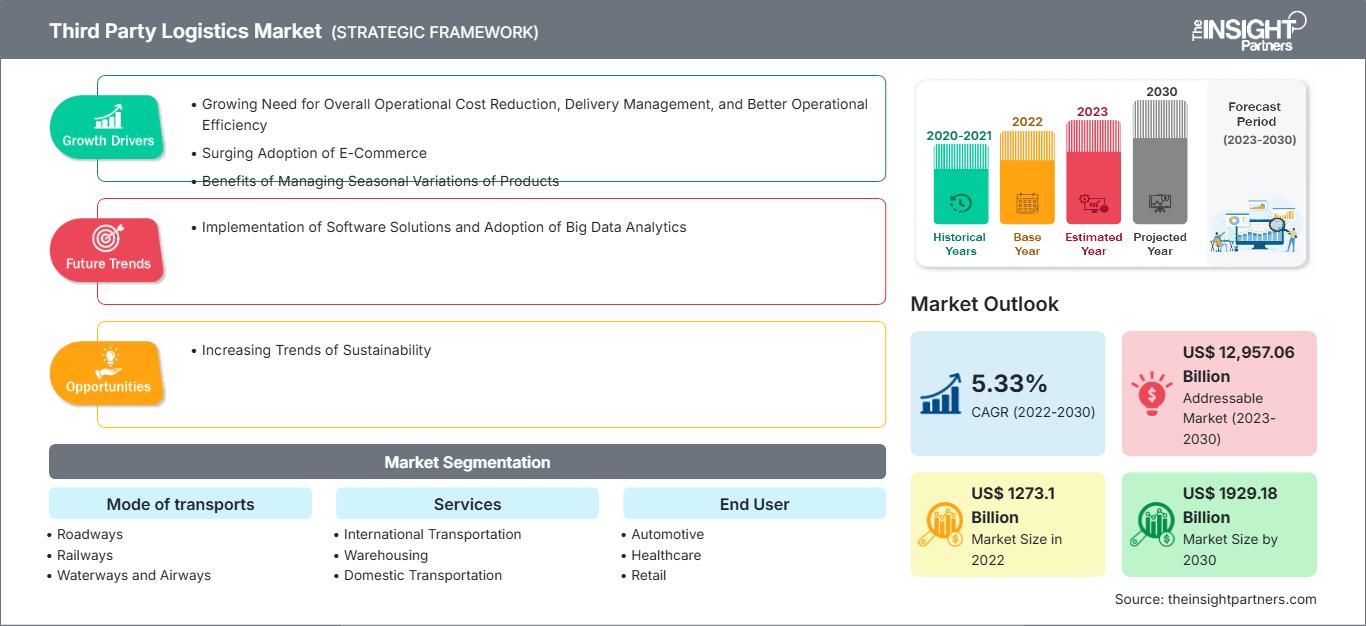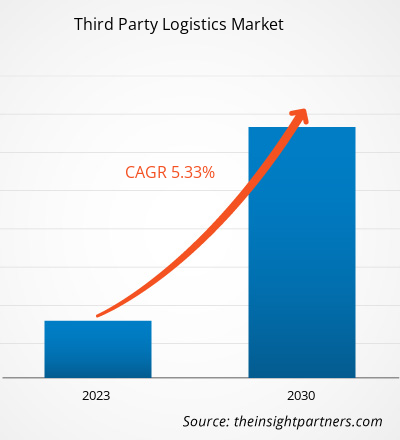2022 年,第三方物流市场规模为 12731 亿美元,预计到 2030 年将达到 19291.8 亿美元;预计 2022 年至 2030 年期间的复合年增长率为 5.33%。
电子商务的日益普及很可能仍将是市场发展的主要趋势。
第三方物流市场分析
电子商务的兴起以及对当日或次日送达的需求推动了对最后一英里配送服务的需求。例如,亚马逊的 Prime 服务为快速配送树立了新的标准,促使第三方物流公司调整其服务以满足这些期望。人们对环境问题和可持续性的意识日益增强,导致对环保物流解决方案的需求不断增加。第三方物流 (3PL) 供应商正在采用电动汽车,优化路线以减少排放,并实施可持续的包装实践,以满足消费者和监管部门的期望。
第三方物流市场概览
将制成品从工厂运输到仓库是整个 3PL 流程的第一步。3PL 企业会在产品抵达仓库或配送中心后进行存储。产品根据其 SKU 进行存储,每个 SKU 都有各自分配的存储空间。进入仓库的物品通常会在此时输入到供应商的追踪系统中。软件集成有助于提高流程的效率和效果。
自定义此报告以满足您的要求
您将免费获得任何报告的定制,包括本报告的部分内容,或国家级分析、Excel 数据包,以及为初创企业和大学提供超值优惠和折扣
第三方物流市场: 战略洞察

-
获取本报告的主要市场趋势。这个免费样本将包括数据分析,从市场趋势到估计和预测。
第三方物流公司已经扩展了资源网络,支持主要公司以经济高效的方式实现扩张。此外,第三方物流公司能够为季节性库存或新产品发布提供充足的资源和灵活的服务。许多机构都会经历客户偏好的季节性变化,因此管理这种波动以保持效率并满足需求至关重要。
软件解决方案的应用和大数据分析的采用
RFID 设备的采用也有望存储数据以方便运输,从而简化产品的跟踪和识别。与运输管理系统相关的软件将减少效率低下和成本。此外,在仓库管理系统通信中使用语音识别软件将有助于订单周转和库存记录,同时降低员工培训需求。除此之外,第三方物流组织对云技术的接受将通过认识到客户访问的需求来响应需求,从而使他们能够更好地应对季节性趋势。
第三方物流市场报告细分分析
有助于得出第三方物流市场分析的关键细分是运输方式、服务和最终用户。
- 根据运输方式,第三方物流市场分为公路、铁路、水路和航空。2023 年,公路运输部分占据了更大的市场份额。
- 根据服务,第三方物流市场分为国际运输、仓储、国内运输、库存管理和其他。2023 年,国内运输部分占据了更大的市场份额。
- 根据最终用户,第三方物流市场分为汽车、医疗保健、零售、消费品和其他。
按地区划分的第三方物流市场份额分析
第三方物流市场报告的地理范围主要分为五个区域:北美、亚太地区、欧洲、中东和非洲以及南美和中美。
第三方物流市场报告的范围包括北美(美国、加拿大和墨西哥)、欧洲(俄罗斯、英国、法国、德国、意大利和欧洲其他地区)、亚太地区(韩国、印度、澳大利亚、日本、中国和亚太其他地区)、中东和非洲(沙特阿拉伯、南非、阿联酋和中东和非洲其他地区)以及南美和中美(阿根廷、巴西和南美和中美其他地区)。就收入而言,亚太地区在 2023 年占据了第三方物流市场份额的主导地位。欧洲是全球第三方物流市场的第二大贡献者,其次是北美。
第三方物流市场区域洞察
The Insight Partners 的分析师已详尽阐述了预测期内影响第三方物流市场的区域趋势和因素。本节还讨论了北美、欧洲、亚太地区、中东和非洲以及南美和中美洲的第三方物流市场细分和地域分布。
第三方物流市场报告范围
| 报告属性 | 细节 |
|---|---|
| 市场规模 2022 | US$ 1273.1 Billion |
| 市场规模 2030 | US$ 1929.18 Billion |
| 全球复合年增长率 (2022 - 2030) | 5.33% |
| 历史数据 | 2020-2021 |
| 预测期 | 2023-2030 |
| 涵盖的领域 |
By 运输方式
|
| 覆盖地区和国家 |
北美
|
| 市场领导者和主要公司简介 |
|
第三方物流市场参与者密度:了解其对业务动态的影响
第三方物流市场正在快速增长,这得益于终端用户需求的不断增长,而这些需求又源于消费者偏好的不断变化、技术进步以及对产品优势的认知度不断提升等因素。随着需求的增长,企业正在扩展其产品线,不断创新以满足消费者需求,并利用新兴趋势,从而进一步推动市场增长。

- 获取 第三方物流市场 主要参与者概述
第三方物流市场的评估是通过收集一手和二手资料后进行的定性和定量数据进行的,这些资料包括重要的公司出版物、协会数据和数据库。以下列出了第三方物流市场的一些发展情况:
- 全球领先的物流服务提供商德铁信可 (DB Schenker) 与领先的运力解决方案提供商 USA Truck 达成协议,根据协议,德铁信可将以每股 31.72 美元的价格现金收购 USA Truck 全部流通普通股。此次交易对 USA Truck 的代价约为 4.35 亿美元,包括承担的现金和债务。 (来源:DB Schenker,新闻稿,2022 年 7 月)
- 全球领先的物流公司德国邮政敦豪集团 (Deutsche Post DHL Group) 今日宣布,将于 2023 年 7 月 1 日将公司名称更改为“DHL 集团”。新名称体现了集团过去几年经历的转型,并强调了集团将重点关注国内和国际物流活动,以此作为未来增长的驱动力。(来源:DHL 集团,新闻稿,2023 年 7 月)
第三方物流市场报告内容和交付成果
《第三方物流市场规模和预测 (2020-2030)》报告对市场进行了详细的分析,涵盖以下领域:
- 第三方物流市场规模以及涵盖范围内所有关键细分市场的全球、区域和国家/地区预测
- 第三方物流市场趋势以及市场动态,例如驱动因素、限制因素和关键机遇
- 详细的 PEST 和 SWOT 分析
- 第三方物流市场分析,涵盖关键市场趋势、全球和区域框架、主要参与者、法规和最新市场发展
- 行业格局和竞争分析,涵盖市场集中度、热图分析、知名参与者和第三方物流市场的最新发展
- 详细的公司简介
- 历史分析(2 年)、基准年、预测(7 年)及复合年增长率
- PEST和SWOT分析
- 市场规模、价值/数量 - 全球、区域、国家
- 行业和竞争格局
- Excel 数据集
近期报告
相关报告
客户评价
购买理由
- 明智的决策
- 了解市场动态
- 竞争分析
- 客户洞察
- 市场预测
- 风险规避
- 战略规划
- 投资论证
- 识别新兴市场
- 优化营销策略
- 提升运营效率
- 顺应监管趋势






















 获取免费样品 - 第三方物流市场
获取免费样品 - 第三方物流市场